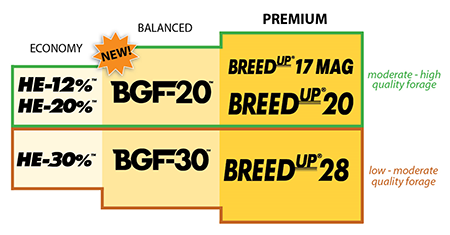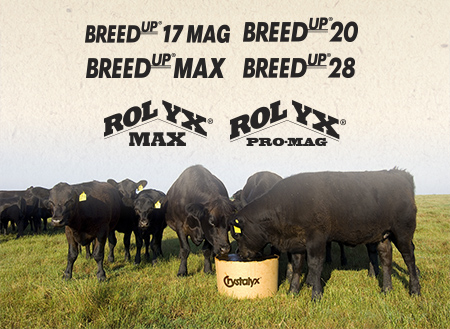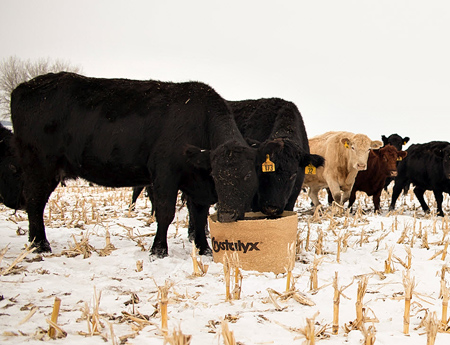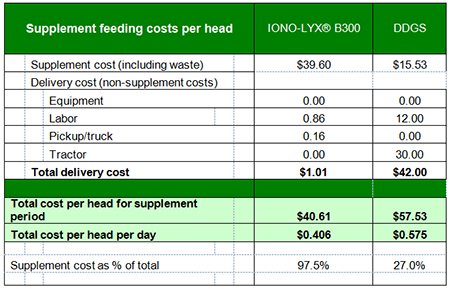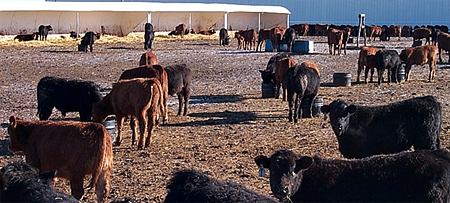Late in the summer of 2014, CRYSTALYX® Brand Supplements came with a new launch, or better described, a new approach of product programs. There really wasn’t any new product, except for one; rather a reformulation of a few and a “categorical” look at different programs. We call this our Economy, Balanced and Premium categories. There were a few blogs written in the latter half of 2014 that mentioned these product categories so I won’t elaborate on the details of each.
Breeding programs and CRYSTALYX
The success of the CRYSTALYX® Breed-Up® family of products has been significant, and for a lot of reasons. One reason is that the Breed-Up® line provides twice the required trace minerals and vitamins for beef cattle at typical intake levels, and this makes sense to provide during the last trimester of pregnancy, and in early lactation when a cow’s nutrient requirements are the highest. Continuing a high plane of nutrition is important up to and “through the breeding season.” But just when is the breeding season through? Is it once the animal is bred; is it 45 days, 60 days? Nutrition post breeding is just as critical, if not more depending on management, types of feedstuffs/forages and/or grazing systems.
CRYSTALYX after calving: Breed-Up products continued use
Nutritionist and feed professionals like to talk a lot about pre-calving nutrition, and stress the fact that a cow’s nutrient requirements climb in the last trimester of pregnancy. This is true and good body condition matters at this time in the reproductive cycle. Still, we may get a little too caught up in this message and overlook the period between calving and breeding; the post-partum interval. In the past several years, we’ve seen a great deal of success in using the CRYSTALYX® Breed-Up® products starting 1-2 months prior to calving. Calves hit the ground healthier and more vigorously, cows clean well and all is good for cow calf, and cowboy’s alike.
Challenges of grazing cornstalks in mid-winter: Don't let cows go backwards
We CRYSTALYX® Bloggers have written several articles about cattle grazing cornstalks and other crop residues. In Nebraska, I often refer to cornstalk residue as our “winter pasture”. In most years, this is a very abundant and relatively inexpensive feed resource and of decent quality. Much information has been written and studied by university extension services in a multitude of states about the effects of cornstalk grazing on cow performance, subsequent grain yield, the need (or not) of protein supplementation etc.
CRYSTALYX Iono-lyx for low cost replacement heifer development
Raising replacement heifers has been studied a lot. As times and cattle have changed, so have some of the systems used to develop replacement heifers. A better focus on low cost development and selection for fertility and longevity makes economic sense. Traditional development programs recommend breeding heifers at 60-65% of their mature body weight as most heifers should have reached puberty by the time they reach this weight. More recently it’s been well documented that conception rates of 85% or greater can be achieved with heifers being bred at 50-60% of their mature weight. Perhaps heifers are reaching puberty earlier or at a lower percent of their mature weight today due to improved genetics, and larger mature cow size vs 20 years ago.
We’re doing a lot of things right: Don’t let up now
Have you ever watched a football game where a clearly superior team was winning, only to let up late in the game and allow the lesser opponent get close or even make a stellar come-back to win? I love NCAA collegiate football and I’ve seen this happen. It’s either frustrating or exhilarating depending on who your team is, but regardless, no team should ever let up the fight on the field.
CRYSTALYX Brigade: Don’t wean calves without it
Over the past few years of blogging on www.crystalyx.com, several articles have been written about using CRYSTALYX® in calf weaning and receiving systems. I’ve been involved in marketing CRYSTALYX® for over 15 years and would honestly say that utilizing it in a weaning/receiving situation is the most visible and expedient way to experience the value in this supplement. The practice of using Brigade® in weaning and receiving programs is well accepted, even automatic with many producers. And folks selling CRYSTALYX® should make Brigade® a part of their nutritional offering.
The energy value of CRYSTALYX is in the forage
Last week Mark Robbins had an excellent blog written in regards to the fat content of CRYSTALYX®. He explained the changes made to fat levels in the “HE” line of products and what that change of 1 or 2% fat really means in terms of actual energy. The bottom line is that the fat content of CRYSTALYX®, while providing some energy, really is a small contributor as an energy source in products containing 3-5% fat. We do not want to discount the value of fat in any supplement as CRYSTALYX® does market a high fat product, Omega-lyx™ which has a much more significant fat level (12%).
CRYSTALYX and equines
It’s true; the vast majority of CRYSTALYX® fed is used for the purpose of supplementing cattle, and beef cattle at that. However, CRYSTALYX® has had products labeled for all classes of equines for a long time having good results with satisfied horse owners using products such as Stable-lyx®. Within the CRYSTALYX® product line, there are actually four products that are labeled for equines; I’ll write here most about Stable-lyx® .
Increased forage utilization starts before we feed hay
It’s often mentioned that a key benefit or the #1 job description of CRYSTALYX® is to improve forage utilization, especially of low quality forage (low protein and high fiber content). This is true and its one of the reasons cattle and CRYSTALYX® work so well together. Cows can digest forage and CRYSTALYX® can help them do it much more efficiently; up to 20% better in some of our past studies.
